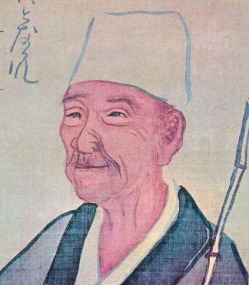What are Haiku and Cinquains?

Because of their close nature, Haiku and Cinquains will be covered together. The Haiku is a Japanese Poem that consists of 17 or less syllables in 3 or less lines. The standard method of organizing these poems is by syllables - 5 syllables in the first line, 7 syllables in the second line, and 5 syllables in the third line. Speaking traditionally, Haiku present a pair of contrasting imagery; one suggestive of a place or time and the other an emotion. The most famous poet who wrote Haiku is Matsuo Basho (pictured, right). Basho is considered to be the "master" of the art form.
Meanwhile, a Cinquain is another type of "recipe poem," which has a similar set up to a Haiku although it is slightly longer. It was inspiried by Haiku. A Cinquain has a set based on words per line rather than syllables; it consists of 5 lines, at a 1-2-3-4-1 word/line ratio.
Line 1: The Name of the Poem (A single Noun)
Line 2: Two words to describe the Noun (two adjective)
Line 3: Three words to describe the feelings or activity based on the noun (three verbs)
Line 4: A four word phrase that describes the noune
Line 5: A single noun that renames the title of the poem.
Cinquain and Haiku do not necessarily have to rhyme; most will not. When a Cinquain has a A-B-A-B rhyming scheme, it's refered to as a Sicilian Cinquain.
A Haiku For You (And a Cinquain Too!)
Objectives:
1: Introduce to the Haiku and the Cinquain
Standards, Benchmarks, and GLCEs (grade level content expectations)
2.1, 5.4, 8.4
R.WS.08.06; R.WS.08.07; R.CM.08.01; L.RP.08.02
Bell Work:
“Think about language for a second. It’s what we use to communicate, but it’s also how we think. Now think about poetry. In what way is poetry connected to language? Why?”
Lesson steps:
Ask the students if they have a poem they would like to share. From there, have them open their books to page 491 and read the three haiku poems out loud. Go over the three questions at the bottom of the page. Tell the students the reason that Haikus are structure as such is because of the uniqueness of the language that they come from. In Japanese, the haiku usually consists of 17 morae (or on) – where a morae is a unit that determines the weight of the syllable that follows. They usually consist of a kigo, or a seasonal reference. They are also written in a vertical line. A few examples are provided below for the teacher to write on the board if they desire:
furuike ya
(古池 や)
(fu/ru/i/ke ya): 5
kawazu tobikomu
(蛙 飛込む)
(ka/wa/zu to/bi/ko/mu): 7
mizu no oto
(水 の 音)
(mi/zu no o/to): 5
The haiku is by Basho. It translates as thusly:
old pond . . .
a frog leaps in
water’s sound
富士の風や扇にのせて江戸土産
fuji no kaze ya oogi ni nosete Edo miyage
the wind of Mt. Fuji
I've brought on my fan!
a gift from Edo
初しぐれ猿も小蓑をほしげ也
hatsu shigure saru mo komino wo hoshige nari
the first cold shower
even the monkey seems to want
a little coat of straw
(Samples from http://en.wikipedia.org/wiki/Haiku)
Explain some of the Japanese language to the students – that each “letter” is actually an ideograph, which is actually a separate word or idea in Japanese. Ask the students how they think this impacts Japanese poetry, in particular, the haiku.
Once the students have read the haiku and gained some familiarity with it, introduce them into the cinquain, and then handout the worksheet. Allow them to work on the worksheet as a group. What they do not finish in class they can turn in as homework.
Extensions and Differentiated instruction:
The worksheets are graphic organizers, helpful for students who are having difficulty visualizing syllables and who have difficulty counting.
Lesson Assessment
Direct: Before they leave, have the students compare the haiku, cinquain and free verse and detail how they are alike and different.
| haiku_and_cinquain_worksheet.pdf |






